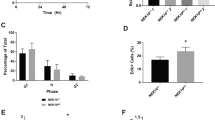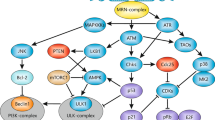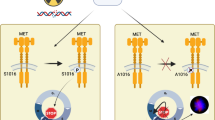Abstract
The cellular response to DNA damage includes growth arrest and activation of DNA repair. Certain insights into how DNA damage is converted into intracellular signals that control the genotoxic stress response have been derived from the finding that the c-Abl protein tyrosine kinase is activated by ionizing radiation and other DNA-damaging agents. c-Abl associates with the DNA-dependent protein kinase (DNA-PK) and is activated by DNA-PK-dependent phosphorylation. The ataxia telangiectasia mutated (ATM) gene product also contributes to c-Abl activation. The demonstration that c-Abl binds to p53, induces the transactivation function of p53 and activates p21 expression has supported involvement of c-Abl in regulation of the p53-dependent G1 arrest response. Interaction between c-Abl and the Rad51 protein has also provided support for involvement of c-Abl in recombinational repair of DNA strand breaks. Defects in G1 arrest and repair predispose to replication of damaged templates and, in the event of irreparable DNA lesions, induction of apoptosis. The available evidence indicates that c-Abl effects a proapoptotic function by a mechanism largely independent of p53. c-Abl also functions as an upstream effector of the proapoptotic JNK/SAPK and p38 MAPK pathways. In addition, c-Abl-dependent inhibition of PI 3-kinase contributes to the induction of apoptosis. The findings thus suggest that, in response to genotoxic stress, c-Abl functions in determining cell fate, that is growth arrest and repair or induction of apoptosis. The physiologic function of c-Abl may reside in control of the cellular response to DNA strand breaks that occur during DNA replication, genetic recombination and gene rearrangements.
This is a preview of subscription content, access via your institution
Access options
Subscribe to this journal
Receive 50 print issues and online access
$259.00 per year
only $5.18 per issue
Buy this article
- Purchase on Springer Link
- Instant access to full article PDF
Prices may be subject to local taxes which are calculated during checkout
Similar content being viewed by others
Author information
Authors and Affiliations
Rights and permissions
About this article
Cite this article
Kharbanda, S., Yuan, ZM., Weichselbaum, R. et al. Determination of cell fate by c-Abl activation in the response to DNA damage. Oncogene 17, 3309–3318 (1998). https://doi.org/10.1038/sj.onc.1202571
Published:
Issue Date:
DOI: https://doi.org/10.1038/sj.onc.1202571



